Thursday 6 June 2024
18.00 LECTURE
Prof. Wessel de Jonge, TU Delft, The Netherlands
→ Artget KCB Gallery, Trg republike 5/I
Redesigning Modern Heritage. About Modern Icons & Everyday Modernism, Historic Value & Design for a Sustainable Future
Prof. Wessel de Jonge
Modern-era buildings deserve our appreciation for their architectural merit, the social developments they represent and the innovative technologies applied in their making. Still, over the years, the architectural heritage of the Modern Movement appeared more at risk than that of any other period. The legacy from the older days celebrates a limited number of outstanding and generally appreciated monuments of the ruling classes from the past. The numerous benchmarks of the Modern Movement on the other hand were designed to create a better life for the masses, but are mostly less appreciated. As a result, the preservation of recent architectural heritage poses different challenges.
New materials applied in modern architecture – like concrete, steel and glass – challenged conservation practice. Buildings featuring fragile materials such as plastered mesh and plastics were apparently not designed to last very long in the first place. Moreover, the fact that a large majority of our building stock was built after the Second World War indicates how the quantity of recent heritage fundamentally challenges our methodology of designation, and the funding of heritage conservation. The sheer quantity of these buildings mostly prevents them to be preserved as museums. Most of them can only be safeguarded by lending them a second lease of life in an economically viable and sustainable way. This requires their adaptive re-use for new functional programs. How does this affect our appreciation for the original qualities of such a structure – and how can we define those qualities that we want to pass on to future generations?
Illustrating such dilemmas, this lecture will depart from the preservation projects of two modern icons in the Netherlands, both dating from 1928: the fragile ‘Zonnestraal’ Sanatorium in Hilversum and the contemporary Van Nelle Factory, which was restored and converted into a business center for the creative industry of Rotterdam, and listed as UNESCO World Heritage in 2014. Such seminal projects provided strategies that were then successfully applied to less-iconic buildings from the 1950s-60s for which a new functional use needed to be found in order to safeguard them. By taking advantage of their original properties, design strategies were developed for their sustainable renewal, allowing such buildings a second lease of life. Many of the architectural strategies that were developed in such redesign projects came together in the recent conservation and adaptive re-use project for Aldo van Eyck’s famous municipal Orphanage of 1960 in Amsterdam. The conversion of the pavilions into an office building for a property development company was awarded the DOCOMOMO prize.
Apart from the heritage challenges involved in these projects, the preservation of modern heritage buildings is just as well a design challenge that requires a particular design approach from the architects involved. As designers today, we have to be ready to explore more innovative strategies for their adaptive reuse and redesign.





